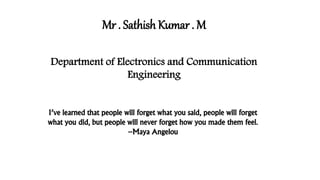
RSA ALGORITHM
- 1. Mr . Sathish Kumar . M Department of Electronics and Communication Engineering I’ve learned that people will forget what you said, people will forget what you did, but people will never forget how you made them feel. –Maya Angelou
- 2. RivestShamir& Adleman MIT in 1977
- 3. What is RSA…? • RSA is an algorithm used by modern computers to encrypt and decrypt messages. • It is an asymmetric cryptographic algorithm. • It is included as part of the Web browsers from Microsoft and Netscape. • It's also part of Lotus Notes, Intuit's Quicken, and many other products.
- 4. RSA PUBLIC KEY PRIVATE KEY Public-key cryptography, also known as asymmetric cryptography, is a class of cryptographic algorithms Messages encrypted using the public key can only be decrypted with the private key.
- 6. OPERATION: • RSA involves a public key and private key. • The public key can be known to everyone, it is used to encrypt messages. • Messages encrypted using the public key can only be decrypted with the private key. The public key is used for encryption. • The key is known to the public . • The private key is used for decryption. • The key is only known to the owner .
- 7. The RSA algorithm involves three steps: key generation, encryption and decryption.
- 8. Why RSA…? • It developed to address two key issues: • Key distribution – how to have secure communications in general without having to trust a KDC with your key • Digital signatures – how to verify a message comes intact from the claimed sender
- 10. RSA CHARACTERISTICS: Public-Key algorithms rely on two keys with the characteristics that it is: computationally infeasible to find decryption key knowing only algorithm & encryption key computationally easy to en/decrypt messages when the relevant (en/decrypt) key is known either of the two related keys can be used for encryption, with the other used for decryption (in some schemes)
- 12. One-way function with trapdoor f x y x y x y f 1 f 1 trapdoor Easy: Hard: Easy: Use trapdoor as the private key. Many public-key cryptosystems are based on trapdoor one-way fu nctions.
- 13. RSA 1 RSA Idea behind RSA * It works in group Z Encryption (easy): Decryption (hard): Looking for a trapdoor: ( ) . If is a number such that 1mod ( ), then ( ) 1 . e e e d n x x x x x x d ed n e d k n k for some , and ( ) 1 ( ) k e d ed n k n x x x x x x x ( ) 1 .
- 14. Integers a b a b a b | : divides , is a divisor of . gcd( a , b ): greatest common divisor of a and b . Coprime or relatively prime: gcd( a , b ) 1. Euclid's algorithm: computes gcd( a , b ). Extented Eucl id's algorithm: computes integers x and y such that ax by gcd(a,b).
- 15. Euler Totient Function ø(n) • when doing arithmetic modulo n • complete set of residues is: 0..n-1 • reduced set of residues is those numbers (residues) which are relatively prime to n eg for n=10, • complete set of residues is {0,1,2,3,4,5,6,7,8,9} • reduced set of residues is {1,3,7,9} • number of elements in reduced set of residues is called the Euler Totient Function ø(n)
- 16. Euler Totient Function ø(n) • when doing arithmetic modulo n • complete set of residues is: 0..n-1 • reduced set of residues is those numbers (residues) which are relatively prime to n • eg for n=10, • complete set of residues is {0,1,2,3,4,5,6,7,8,9} • reduced set of residues is {1,3,7,9} • number of elements in reduced set of residues is called the Euler Totient Function ø(n)
- 17. Euler Totient Function ø(n) • when doing arithmetic modulo n • complete set of residues is: 0..n-1 • reduced set of residues is those numbers (residues) which are relatively prime to n eg for n=10, • complete set of residues is {0,1,2,3,4,5,6,7,8,9} • reduced set of residues is {1,3,7,9} • number of elements in reduced set of residues is called the Euler Totient Function ø(n)
- 18. RSA ALGORITH EXAMPLE Choose p = 3 and q = 11 Compute n = p * q = 3 * 11 = 33 Compute φ(n) = (p - 1) * (q - 1) = 2 * 10 = 20 Choose e such that 1 < e < φ(n) and e and n are coprime. Let e = 7 Compute a value for d such that (d * e) % φ(n) = 1. One solution is d = 3 [(3 * 7) % 20 = 1] Public key is (e, n) => (7, 33) Private key is (d, n) => (3, 33) The encryption ofm = 2 isc = 27 % 33 = 29 The decryption ofc = 29 ism = 293 % 33 = 2
